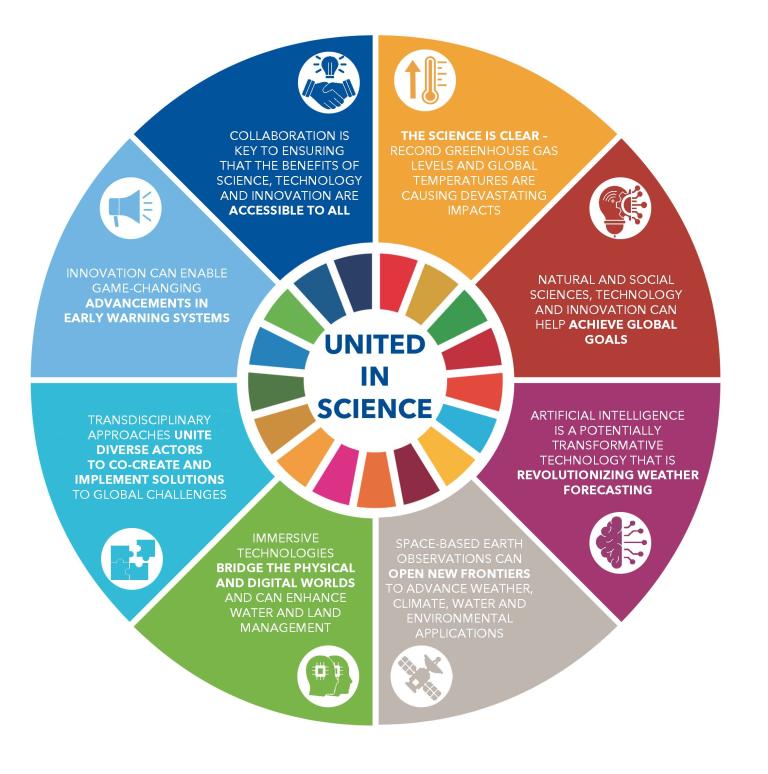United in Science 2024
Release of United in Science 2024 report

United in Science 2024, the 5th edition of the report, was launched by WMO in September to align with the Summit of the Future, which aimed to demonstrate how we can collectively achieve global goals, such as the Paris Agreement of the United Nations Framework Convention on Climate Change (UNFCCC), Sendai Framework for Disaster Risk Reduction 2015-2030 and 2030 Agenda for Sustainable Development. However, with global temperatures reaching record highs and the impacts of climate change and hazardous weather events reversing development gains, a sustainable future for all is at risk.
United in Science, which compiles the latest climate science-related updates from key global partner organizations, reports that global greenhouse gas (GHG) emissions rose by 1.2% from 2021 to 2022, reaching 57.4 billion tons of carbon dioxide (CO2) equivalent. Globally-averaged surface concentrations of CO2, methane and nitrous oxide also reached new highs. By a large margin, 2023 was the warmest year on record and the first half of 2024 has already witnessed exceptionally high global temperatures and many extreme weather events that have had devastating impacts. There is an 80% chance that the global mean near-surface temperature will temporarily exceed 1.5 °C above pre-industrial levels in at least one of the next five years. Further, despite progress in mitigating global GHG emissions, the emissions gap remains high: if current policies are continued, it is estimated (with 66% probability) that global warming will be limited to a maximum of 3 °C throughout the century, highlighting the urgent need for ambitious mitigation and adaptation action.
On a positive note, United in Science highlights that the power of natural and social sciences, technology and innovation provide an unprecedented opportunity to get back on track to achieve global goals and a better world for all. For example, Artificial Intelligence (AI) and machine learning are revolutionizing weather forecasting and could make weather modelling faster, cheaper and more accessible to lower-income countries. Innovations in space-based Earth observations may also pave the way for improved weather prediction, enhanced understanding of our climate system and more robust environmental monitoring. And immersive technologies, such as digital twins and virtual reality, are bridging the physical and digital worlds, providing innovative solutions to enhance water and land management.
However, the report emphasizes that global challenges cannot be addressed by science and technology alone – they require a transdisciplinary approach to co-create and implement solutions. Transdisciplinary approaches unite diverse actors – such as scientists, policy makers, development practitioners and civil society, including local and Indigenous communities – to apply natural and social sciences in local contexts. These approaches can enhance trust in National Meteorological and Hydrological Services (NMHSs) and the resilience of local communities.
The report also highlights how the call for Early Warnings for All exemplifies the integration of natural and social sciences, technological advances and transdisciplinary approaches to protect lives, livelihoods and the environment. Advancements in AI, space-based Earth observations and immersive technologies can contribute to this critical initiative by enhancing weather forecasting, contextualizing and communicating information for decision-making, and creating interactive and educational simulations to support anticipatory action. Additionally, transdisciplinary approaches, including participatory engagement methods such as citizen science, enhance the effectiveness of early warnings through the co development of knowledge and solutions.
Although advances in weather, climate, water and related environmental and social sciences offer huge potential to support global goals, the report highlights the need to address data gaps, limited financial resources, inadequate capacity to utilize emerging technologies as well as governance challenges. Moving forward, global partnerships between governments, the private sector, international organizations, civil society, academia, youth and local communities will be essential to address these challenges and ensure that the benefits of natural and social sciences, technologies and innovations are accessible to all.
Lead contributing organizations to the report include: WMO, Met Office (UK), Global Carbon Project (GCP), United Nations Environment Programme (UNEP), European Centre for Medium-Range Weather Forecasts (ECMWF), United Nations Office for Outer Space Affairs (UNOOSA), International Telecommunication Union (ITU), United Nations Convention to Combat Desertification (UNCCD), and the International Science Council (ISC).



